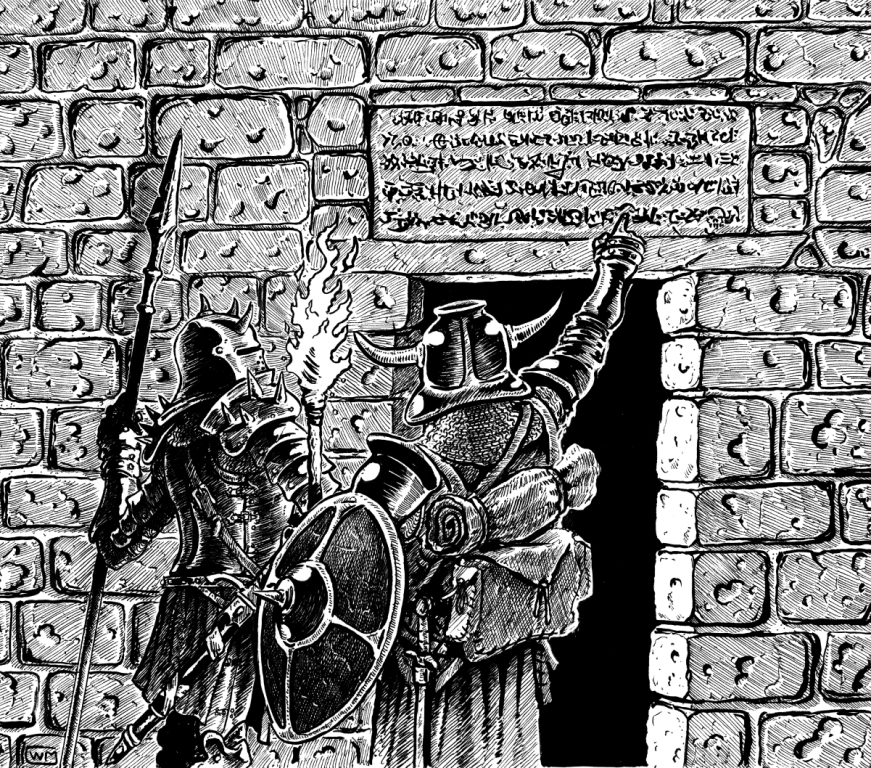Campaign worlds need deep dungeons, lost dwarven holds, crumbling castles, ebon caverns and dusty necropolises for the PCs to explore. Such locales need suitably evocative names.

Whether designing a rumour or legend about a dungeon, a small self-contained complex or an entire megadungeon, a decent name is vital for setting the theme and style of the complex. An evocative name also builds the players’ expectations and may even give them helpful hints about what might lurk within.
The tools herein can be used to name small and large dungeon complexes as well as distinct portions or levels within a complex.
Naming Styles
Obviously each dungeon must have a unique name, but beyond that the naming convention of most dungeons can take many forms. Each name, however, comprises one or more distinct parts. These parts are:
- Complex: All dungeons take one of several forms. Dungeons, castles, catacombs, caves and so on can all serve as a dungeon. To determine the dungeon’s type, roll on Table A.
- Descriptor: Many dungeons have a descriptor that describes the general condition or perception of the locale. Dungeons can be cursed, fallen, ruined, shadowed and so on. In addition, if a dungeon is named for a specific person, group or kingdom it may have a second descriptor that describes that subject. To determine the dungeon’s descriptor, roll on Table B and pick the most appropriate word from those listed alongside the generated result.
- Subject: Many dungeons also have a featured subject. A dungeon associated with a magic throne, for example, might include that feature in its name. To determine the dungeon’s subject, roll on Table C and pick the most appropriate word from those listed alongside the generated result.
- Proper Name: Sometimes a dungeon is named for a specific individual – perhaps a powerful wizard who once dwelled therein or a famous adventurer who died within. Occasionally, locales are also named for the tribe that claims the place. Either pick an appropriate name from your campaign or roll on Table D to determine whose name to associate with the dungeon
To randomly determine the structure of a dungeon’s name, choose one of the naming formats below:
- The [descriptor] [complex] of [proper name]
- The [descriptor] [complex]
- The [descriptor] [complex] of the [descriptor] [subject]
- The [descriptor] [complex] of [tribe name]
- The [complex] of [descriptor]
- [proper name]
- The [complex] of [descriptor] the [descriptor]
- The [descriptor] [complex]
For example, using the above formats, a GM can generate names such as:
- The Gate of Sorrow
- Borath’s Hold
- The Forsaken Citadel
- Arak-Zol
- Shadowed Vault of the Forsaken Goblins
Legends
The great thing about creating a name for a dungeon is that it inevitably poses questions which are not only fun to answer but also add depth, verisimilitude and flavour to the campaign world. For example:
- What powers does the pillar hidden in the Catacombs of the Sundered Pillar have and why was it sundered?
- What lurks in the darkness of the Trackless Reaches of the Ebon Cavern?
- Who or what lies in the Sepulchre of Tor Baroth? Is Tor Baroth its most famed “resident,” its guardian or the name of a fallen kingdom?
Help Fellow Gamers
Do you have any other dungeon design tips related to this topic? If you do, please leave them in the comments below and help your fellow GMs design better dungeons today!
This article is part of Dungeon Design Fortnight. Dungeon Design Fortnight celebrates Raging Swan Press’s upcoming release of GM’s Miscellany Dungeon Dressing – a huge 336-page tome dedicated to all aspects of dungeon design and dressing. This article, along with loads of other useful information, appears in the book. I’m insanely proud of GM’s Miscellany Dungeon Dressing and I hope if you are thinking about designing dungeons you check it out.
4 thoughts on “Dungeon Design: Dungeon Names”